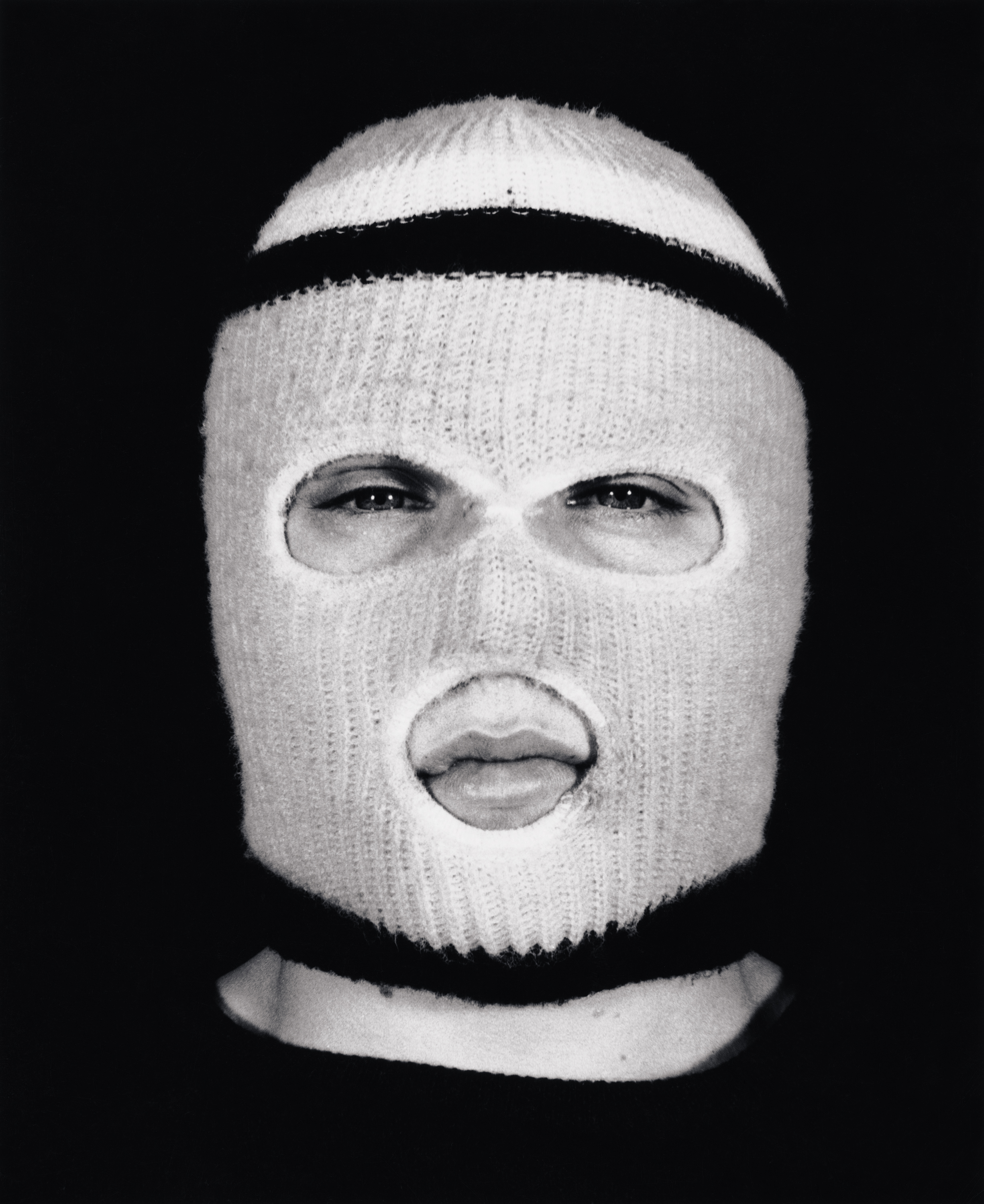
‘An efficient test of where you stand on contemporary art is whether you are persuaded, or persuadable, that Chris Burden is a good artist. I think he’s pretty great. Burden is the guy who, on November 19, 1971, in Santa Ana, California, produced a classic, or an atrocity (both, to my mind), of conceptual art by getting shot. “Shoot” survives in desultory black-and-white photographs with this description: “At 7:45 P.M. I was shot in the left arm by a friend. The bullet was a copper jacket .22 long rifle. My friend was standing about fifteen feet from me.” Why do such things? “I wanted to be taken seriously as an artist,” Burden explained, when I visited him recently at his studio in a brushy glen of Topanga Canyon, where he lives with his wife, the sculptor Nancy Rubins.
‘“Shoot” was one of a number of perfectly repellent performance pieces of the early nineteen-seventies in which Burden subjected himself to danger, thereby creating a double bind, for viewers, between the citizenly injunction to intervene in crises and the institutional taboo against touching art works. (Such, at any rate, was my analysis of the distinctive nausea that I felt in thinking of those things, which I avoided witnessing in person.) He spent five days in a small locker, with a bottle of water above and a bottle for urine below; slithered, nearly naked and with his hands held behind him, across fifty feet of broken glass in a parking lot; had his hands nailed to the roof of a Volkswagen; was kicked down a flight of stairs; and, on different occasions, incurred apparent risks of burning, drowning, and electrocution.
‘Usually performed for small audiences, these events became word-of-mouth sensations on a radically minded grapevine in art schools, new contemporary museums, and grant-funded alternative spaces—an emerging academy of the far out. Anti-commercial sentiments held sway in those circles, although not altogether heroically, given the concurrent slump in the art market and the flow of patronage from such sources as the National Endowment for the Arts. (Between 1974 and 1983, Burden received four N.E.A. grants.) Earthworks, executed in remote locations, were the conceptual art that came closest to being popular. They had in common with Burden’s performances the fact that almost nobody saw them, except by way of documentation. The avant-gardism of the time wasn’t only reliant on publicity; it was effectively about the mediums of information—specialized magazines, insider gossip—through which it became known. Burden strummed the network like a lyre.
‘He was immediately taken very seriously, as the most extreme and enigmatic of provocateurs in a subculture that, in highly educated ways, reflected the political disarray of the nation during the seemingly eternal Vietnam War, and prefigured the swing-barrelled rage of punk. By 1977, he had created performance pieces in two dozen American and European cities. They constituted a theatre of passive-aggressive cruelty. For one, in 1972, in Newport Beach, he sat immobile in a chair, wearing dark glasses, facing two cushions and an inviting box of marijuana cigarettes. Visitors naturally assumed that he was watching them, but the insides of his glasses were painted black, and he refused to speak. He reported, in his record of the work, “Many people tried to talk to me, one assaulted me and one left sobbing hysterically.” Plainly, Burden was not in sympathy with his supposed community.
‘After late seventies, Burden specialized in one-off wonders like “A Tale of Two Cities” (whose details yield a wealth of technological and social history) and insouciant engineering feats like “Hell Gate,” as well as technological stunts involving self-designed cars, boats, and laboratory equipment. (He reconstructed a primitive early television and a nineteenth-century apparatus for measuring the speed of light.) Some works had political content, such as a chilling response to Maya Lin’s Vietnam Veterans Memorial: three million Vietnamese names, symbolizing the native dead of that war, engraved on hinged copper panels. (Made in 1991, it belongs to Chicago’s Museum of Contemporary Art.) Others were hoots: a rubber-band-powered model plane launched in the aisle of a Concorde in flight, to attain a ground speed of Mach 2.05 plus ten miles per hour. (Burden sells relics of such actions; in this instance, the little plane mounted in a glass case.) In his studio, he showed me a work in progress: parts of what will be a huge model city crisscrossed by roller-coasters of hundreds of track-racing toy cars. The cars will run continuously, until they wear out, at the equivalent, for their size, of well over a hundred miles an hour. (A smaller version, shown in 2004 in Kanazawa, Japan, provoked acute anxiety in its viewers, Burden remarked happily.) There is an inevitable slackness, conceptually, to these works, which colonize the “free spot” that Burden’s daring carved out. The history of the avant-garde comes down to this: a boyish gimcracker diverting us by diverting himself. Worse things have happened.’ — The New Yorker
____
Further
Chris Burden: Extreme Measures
Chris Burden @ Gagosian
Chris Burden @ Ronald Feldman Gallery
‘Public Offering’
‘Weapons of Choice: Chris Burden Talks Porsches, Cannons, Sailboats and Meteorites’
‘Chris Burden: The Body Artist’
‘Heavy Metal Fatalist’
‘New York museum ups security as gold bar sculpture goes on show’
Chris Burden @ Electronic Arts Intermix
‘Everything You Need to Know About Chris Burden’s Art Through His Greatest Works’
‘FACE THE DRAGON HEAD-ON’
‘Seeing Gray: The Power of Interpretation in Chris Burden’s Shoot’
Video: Chris Burden and Lisa Phillips in conversation
‘Art Destroying Architecture: Chris Burden’s Samson
‘Chris Burden Isn’t Your Typical Oil-on-Canvas-Bugatti Car Artist’
‘He Has Forsaken the Violent Art of His Youth’
_____
Extras
Trailer: ‘Burden’ (2016)
Chris Burden | Klash ! L’art en acte | ARTE
Conversation With Chris Burden
Inside the Artist’s Studio: Chris Burden
_____
Interview (1980)

David Robbins: Did you have The Big Wheel fabricated?
Chris Burden: No, no, I made it. All I bought was the two halves of the iron cast for the wheel. They were out in this field with grass growing around them. I took a chance that the halves would fit together. Originally I was going to make it out of concrete. My assistant and I had to engineer that axle and the entire trestle work — literally make all that.
DR: Are people aware of the fact that you made it? Given the memory of so much minimal, fabricated art, I think it’d be great to let people know that it was all made by you. You didn’t just buy a wheel and a motorcycle and connect them.
CB: To say that I personally made it, you mean?
DR: Yeah. Nowadays many people assume that a work of this scale and nature is either fabricated or a combination of found objects.
CB: Instead of Donald Judd calling into the shop…. I never even thought about that. The motorcycle in the Big Wheel is mine, one that I had used.
DR: The elements in the piece look so impersonal and they’re actually decidedly personal.
CB: That’s why it relates to the CBTV — the kind of neanderthal TV — and the B-Car. Both of which I made by hand.
DR: What’s your aim with those pieces?
CB: Those are a little different than the Wheel. The CBTV and the B-Car are like an education for me. The car and the TV are two of the most successful products of Western industrialism in terms of how many they make and how everybody has one. Making those, my thinking is “Here I am on a desert island, and I know that those things exist, and I want them again. I’m not an engineer but I have a hunch how they work, so let’s go to it. I don’t have to buy my shit at the factory like you guys.” That’s kind of the active idea in those pieces.
DR: Self-reliance.
CB: Right.
DR: How do those works differ from the Big Wheel, in your view?
CB: The Big Wheel doesn’t have a function we can relate to. It’s functionless.
DR: Poetic.
CB: Right. I’d never made anything that big. You know, we got it up there…something that big isn’t stationary. The first time I tried it, I wasn’t certain that it wouldn’t wobble off and go whipping through LA!
DR: I recently read an article about the growth of West Coast art. Do you think that just as the world’s art center shifted from Europe to New York after World War II, the center is again shifting, to Los Angeles? Does it feel to you like the importance and, well, dogma of New York art is disintegrating and that the art market is becoming more decentralized?
CB: In the last ten years, definitely.
DR: The media machine is still in New York.
CB: The marketplace too. You see some tired work because of the marketplace mindset — people just cranking it out sometimes.
DR: I’ve come to think of Soho as a theme park. What attracts you about California?
CB: I grew up in Europe and on the East Coast, and California is so different. I think the openness of California, its feeling of possibility, for me results in a kind of work that would be much different were I to move to New York. I can’t see how I could live in a loft in New York and make the Big Wheel. It might never have occurred to me to make it. I have a certain mobility in LA. I have a pick-up truck. If I want something, I look it up in the Yellow Pages and I drive there and get it — get it done or get the people who could answer the question.
DR: LA is more pop. Television seems to be a recurring theme in the work. A baby boomer’s theme! Do you actually watch a lot of television?
CB: I’ve gone through periods where I watch a lot and I go through periods where I don’t watch at all.
DR: Do you know why you are drawn to television in your work?
CB: Television is incredibly powerful.
DR: And you use that power by putting your ads on TV?
CB: I go out and buy the time, put the stuff on local stations.
DR: You use the TV system.
CB: People don’t quite understand that. They don’t realize the significance of the ads, as a systems approach. Nothing along those lines has ever been written about my ads. To me it is real significant. Because I don’t have a million dollar production budget, the ads are primarily gestural, I guess, but they still effect very much those people who see them. Especially other artists, people who know me, because I’m breaking that monolithic idea of TV — that it’s this one way street that comes at you and there is always some other guy up there in control.
DR: You personalize the system.
CB: Right. You don’t like what you see? Go get your savings book and change it.
DR: Did the ads appear on cable-access television?
CB: No, on local stations. Saturday Night Live also ran one.
DR: Were those local stations resistant?
CB: Sure. Absolutely. The first one I did was just a little ten second film clip, in ’73, on 16mm film. I walked into the TV station with a little film can. The response was, predictably, “Who are you? What is this?” Like any other advertiser, I wanted to run this ad. The guy at the station viewed it, and saw a black and white of me crawling through this glass. It looked like stars or marshmallows. And that was for about seven seconds. Then my name and title, Through the Night Softly. I could have been in outer space or something, it was very abstract. But it’s also real crude, so the salesman was looking at me like “What the hell is this?”
DR: As long as you were willing to pay for it, they were open?
CB: I said “I’m an artist, I want people to see my name. It is an ad in that sense.” The salesman bought that argument. This ad was to run on Channel 9, a local Los Angeles station, for a month, after the eleven o’clock news. The amount of money I paid was peanuts to them but to me the discovery that I could do this was priceless.
DR: What kind of response did the station get?
CB: It got taken off the air! This happens almost every time I do an ad on TV. Three out of four times, the station manager will be at home watching his own channel on TV and my ad will come on. The ads get cleared to a certain level, and then the guy at the top sees it at home and freaks.
DR: “Surprise!”
CB: I did another one in LA again a year or two later. Poem for LA was thirty seconds long and ran on two stations for two or three weeks. In the ad my head appeared and I’d say, “Science has failed,”, then block letters of those words would come on. Then I’d say “Heat is life,” and those words would appear. Then I’d say “Time kills” and again words appeared. It repeated through that cycle three times.
DR: What did the public think of these?
CB: I’d get all kinds of reactions. With that one, people would recognize me in the supermarket or the laundromat for a while afterwards. It was weird. “Hey, I saw you on TV, man, what did you mean by that?” I would answer, “Well, it’s just what it said. It’s nothing more than what you see.”
DR: Did you want to be famous?
CB: I always wanted to be respected. There are people who think I’m totally wacko, because of my work. They’re afraid to visit the studio!
DR: I had the impression with, say, The Visitation [1974], that the idea of fame was an element of the work.
CB: You can use fame, include it as a material. I used it in the first performance piece I did in New York, Back to You, at 112 Greene Street. I was in an elevator, hidden, you couldn’t see me, and volunteers were asked — this was a month after Newsweek dubbed me the “Evel Knievel of the art world” — “he used to do things to himself, obviously his next step is to use you folks, right?”. I was definitely using that — the piece is called Back to You! I told the audience, more or less, “One person gets to stick push pins in me, if you so desire.” For a while, there was dead silence, in a room of two or three hundred people, nobody was volunteering. Finally, one person — the artist Larry Bell — stepped forward and volunteered. His arm was shaking so bad he dropped the first pushpin.
DR: Most people who might think of an idea that involved physical pain in a piece, would say, “Well, as an idea it’s good but I don’t think I want to put myself through that.”
CB: It was important to do it. It had to be done at the time. It seemed right. When something’s right… You have to do it if it feels right. That physical thing is weird though. You have to look at it in context. I mean football players go out there, boxers, race car drivers… People do put themselves at risk.
DR: How do you feel today about early works such as Shoot or Trans-fixed?
CB: I think they’re still important pieces. They’re strong enough, still, today, that people expect me to repeat them! I had a funny thing happen to me last month. These people called me up and asked, “Hey, do you want to do a performance at a big rock and roll concert? Ten thousand people. Do you want to perform between sets?” I then made the mistake of telling them what it was I was going to do — my Atomic Alphabet. The stage could be cleared, with a hard spotlight and, BLAM, it could just blast out. It would have been perfect. When I told the organizers my plan, their response was “We were hoping you would do something more physical.”
DR: “We were hoping you might hurt yourself more.”
CB: Yeah. “You tell me what to do, then!” Incidentally, someone just broke into my studio and stole the rifle that I’d used in Shoot.
DR: You never sold that rifle?
CB: No. That wasn’t the art. A relic is by definition an object, used in performance. I hadn’t decided whether the rifle was a relic. It could have been.
DR: It would be now!
CB: It will be now! For income tax purposes!
DR: Do you think that an artist is responsible for bringing political or social issues to the public’s attention?
CB: I think that I have a responsibility to be an artist. I feel that sometimes. It could be construed as a political responsibility but I’m not sure that’s really true. Depends on how broad a definition of politics we’re using.
DR: Broadly, the freedom to act.
CB: Well, I’ve been in trouble with the FBI. I’ve been that free to act, at least!
DR: Was it for 747 [1973], the piece in which you shot at the airplane passing overhead?
CB: Yeah. They came by and asked me a bunch of questions. It was very interesting.
As far as the nature of the piece, the plane wasn’t in any danger. I went down to the beach and fired a few shots at a plane flying over head. I wasn’t trying to shoot the plane down, it was more a gestural thing, trying to get it photographed — to make an image. I knew that if I wasn’t going to be arrested on the spot that there was no fucking proof that it had happened. But when the FBI came, it was maybe four and a half years later — long after the fact. The FBI came by the studio and left a little calling card. A meeting was arranged at my lawyer’s house. I figured it was better to meet at the lawyer’s house so the FBI guy wouldn’t be so freaked. I mean, I didn’t have any furniture at my place!
The FBI had become aware of the piece because a picture of it had been published in Oui magazine or someplace, and some executive had called the FBI and complained. “Who is this Chris Burden? He was shooting at an airplane and he’s not in jail? How come?” The FBI guy was dispatched to check it out. He arrived in his beautiful suit. My lawyer had spread out all this information on the table: “This is performance art. Here are the main artists. Here are photos of past performances.”
DR: Did the FBI guy get it?
CB: He was getting educated about it, getting a feel for it. He was just there to check it out, not to pin me down or arrest me. I explained to him, it’s a performance, it’s about the goodness of man — the idea that you can’t regulate everybody. At the airport everybody’s being searched for guns, and here I am on the beach and it looks like I’m plucking planes out of the sky. You can’t regulate the world.
DR: You are probably one of the few artists to have your name on a dossier at the FBI. Any trouble with the law aside from that piece?
CB: I was arrested while performing an earlier piece, where I lay in the street, on La Cienega Boulevard [Deadman, 1972] in Los Angeles. I was next to a parked car, but still in the lane. I was covered with a tarp, and there were two flares around me. The cops came — but that wasn’t part of the piece! The plan was: the flares burn out, I get up, roll up the tarp, and leave.
DR: With the flares dictating the time of the piece…
CB: Right. The flares were the time element.
DR: What was your state of mind, laying there under the tarp?
CB: It’s a force of will more than anything else. You’re gonna do it, you’re gonna follow through. While I was laying under the tarp I was scared I was going to get run over, but after a little while it became pretty evident that wasn’t going to happen, that it wasn’t too much of a danger. I also did a piece called Doomed where I lay behind a plate of glass in a museum and waited for the museum staff to put an end to it. Although they didn’t know that!
DR: You didn’t inform them.
CB: No, purposefully. It was up to them to figure out that they had to end it. So I was just hoping they’d end it! I was tired of laying there.
DR: It’s such a special situation, that aside from an experience of the will, I would think that there would be kind of a spiritual hum to the work as well…
CB: Certainly in the longer pieces there is. In ’75 I spent 22 days on a shelf [White Light/White Heat], in the gallery we’re in now, Feldman. Didn’t see anyone, didn’t eat.
DR: How could you not eat for 22 days?
CB: Easy. I had fruit juice, celery juice, stuff like that. I never saw anybody, though. Just bottles getting pushed up over the ledge or taken away by hand. What’s weird is that you start to like it there. You feel power, because nobody knows what’s going on. I don’t just sit up there and meditate. I go to work, psychologically.
DR: Were you ever tempted, while you were laying up there, to address skeptics in the audience by making a small rustling noise or cough?
CB: No. I liked the fact that people went away saying “Ruthie, he’s not there. I’ve seen art shows like this, that Robert Irwin guy. There’s just nothing there.”
DR: Is magic an interest of yours?
CB: Yeah. It has a certain power, the theater of it.
___
Show
Shoot, 1971
‘At 7:45 p.m. I was shot in the left arm by a friend’. — Chris Burden


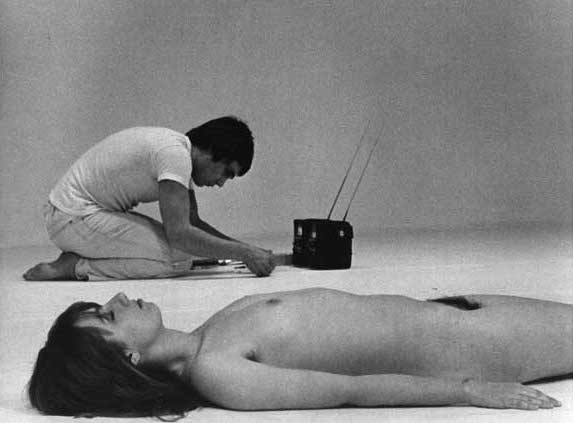
Match Piece, 1972
‘Chris Burden’s performance took place in the large room on the right side of the gallery. Most of the floor was covered by white butcher paper, with a space near the entrance left for the audience to occupy. The whiteness of the paper, reflecting the whites of the walls and ceiling, created an all-white space. The performance began a little after eight o’clock and the activity of the piece got under way before the audience was allowed to enter. At that moment Burden was kneeling directly on the floor, with his right side facing the audience, toward the back of the space. He was wearing a white T-shirt, off-white Levi’s, no belt and bare feet. He stared intently at two tiny black, transistorized black-and-white TV sets that sat side by side in front of him. At least one TV was on throughout the whole performance, with sound. Burden periodically switched from one to the other, or had both going at once. The sound was quite loud. About ten or fifteen feet away, between him and the audience, a naked girl lay on her back with her eyes closed and hands at her side. As he watched the TVs the artist was wrapping aluminum foil around the heads of matches and heating them until they lit. The jet pressure caused by igniting the match heads shot them into the air, and he used a makeshift launcher made from two bent paperclips to fire these little missiles in the direction of the girl. The direction and distance the matches flew varied greatly and did not seem very accurately controllable by Burden. In all probability fewer than fifteen matches hit the girl. When hit by the hot matches she usually flinched, and when one landed directly on her she swept it off. The average range of the cardboard matches was about the distance to the girl while the wooden ones were more powerful and more difficult to control. Many of them misfired, but a few flew forcefully into the audience space. Because Burden prepared and fired each match separately the overall pace was very slow, about one match per minute. The artist at no time showed any interest in the audience or the girl. His face had the sort of unself-conscious and disinterested expression one might expect from someone who was alone. He looked calm and absorbed in what he was doing.’ — East of Borneo

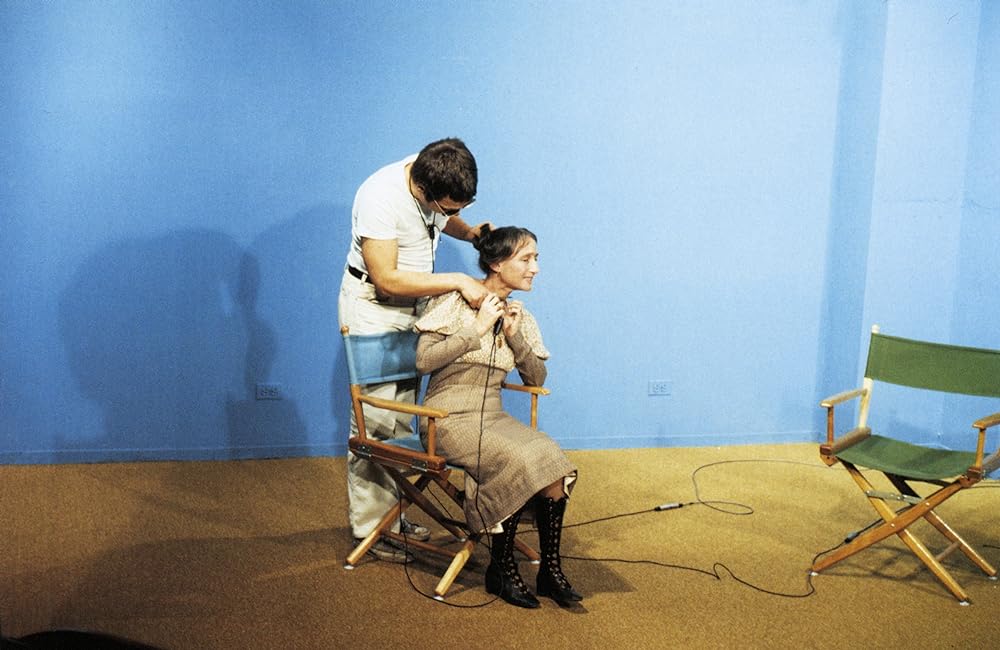
TV Hijack, 1972
‘On January 14 I was asked to do a piece on a local television station by Phyllis Lutjeans. After several proposals were censored by the station or by Phyllis, I agreed to an interview situation. I arrived at the station with my own video crew so that could have my own tape. While the taping was in progress, I requested that the show be transmitted live. Since zhe station was not broadcasting at the time, they complied. In the course of the interview, Phyllis asked me to talk about some of the pieces I had thought of doing. I demonstrated a T.V. Hijack. Holding a knife at her throat, I threatened her life if the station stopped live transmission. I told her that I had planned to make her perform obcene acts. At the end of the recording, I asked for the tape of the show. I unwound the reel and destroyed the show by dousing the tape with acetone. The station manager was irate, and I offered him my tape which included the show and its destruction, but he refused.’ — Chris Burden
Bed Piece, 1972
‘A young man stripped to his underwear, climbed into bed, and stayed there for twenty-two days. In a large white room with a bare floor, the single bed is pushed against the far wall. Chris Burden, aged twenty-five, wears a white singlet and pulls the white bed-covers up to his armpits. He hasn’t given any instructions to Josh, who soon devises a pattern of providing food and water and taking care of Chris’ toilet needs. The temperature is fairly constant and mild, but Chris sometimes shivers or sweats.’ — National Portrait Gallery
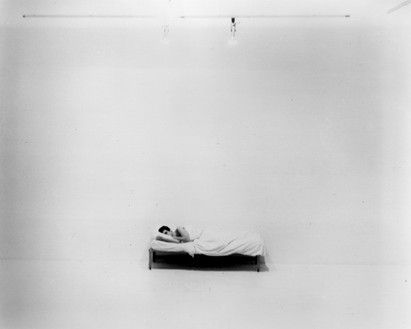
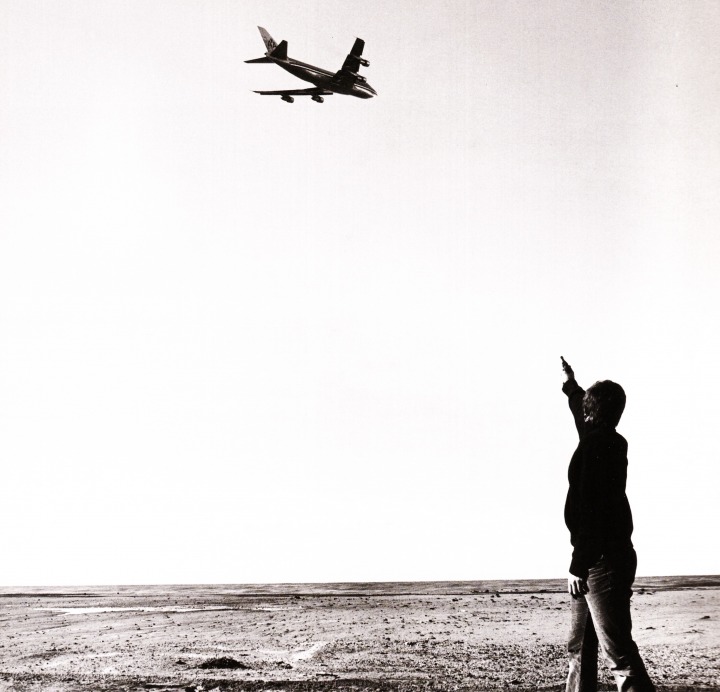
747, 1973
‘At about 8 am at a beach house near the Los Angeles International Airport, I fired several shots with a pistol at a Boeing 747’. — Chris Burden
Through The Night Softly, 1973
‘By buying ten seconds of television advertisement time on a local Los Angeles channel and using it to show, without any comment, an excerpt from Through the Night Softly, 1973, in which Burden, nearly naked, crawled through fifty feet of broken glass, the artist brilliantly subverted commercial television.’ — Middelheim Museum
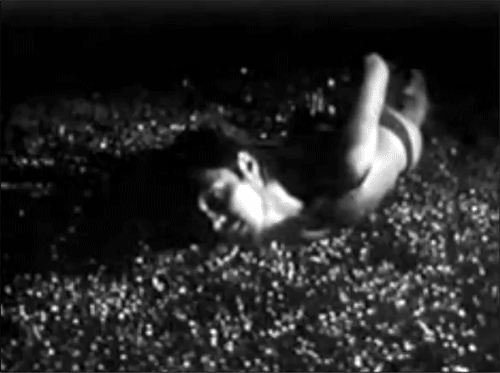
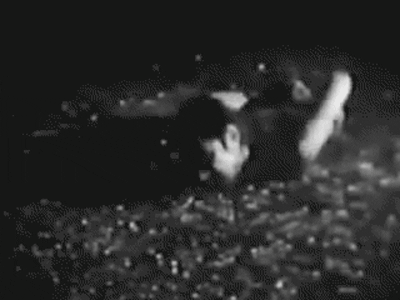
17:18 – 19:37
Icarus, 1973
‘At 6 p.m. three invited spectators came to my studio. The room was fifteen feet by twenty-five feet and well lit by natural light. Wearing no clothes, I entered the space from a small room at the back. Two assistants lifted onto each shoulder one end of six foot sheets of plate glass. The sheets sloped onto the floor at right angles from my body. The assistants poured gasoline down the sheets of glass. Stepping back, they threw matches to ignite the gasoline. After a few seconds I jumped up, sending the burning glass crashing to the floor. I walked into the back room.’ — Chris Burden
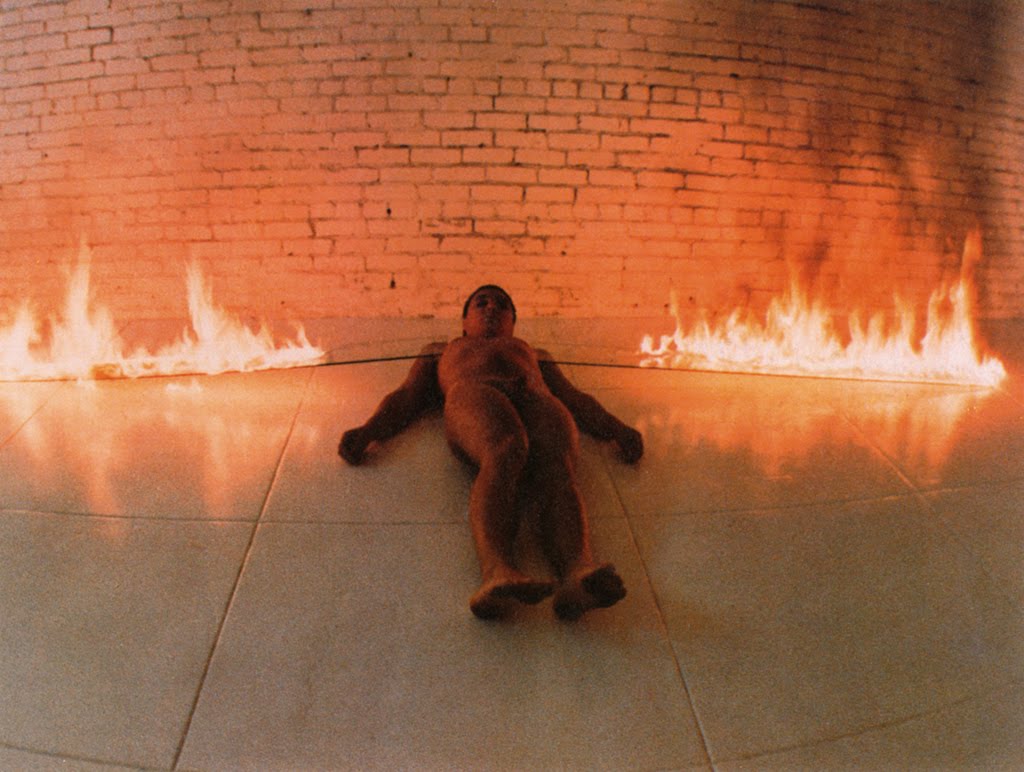
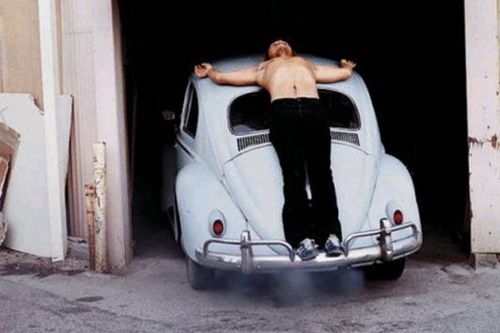
Trans-Fixed, 1974
‘In 1974, performance artist Chris Burden was nailed to the back of a Volkswagen Beetle, which was pushed out of a garage, the engine revved for two minutes, and then pushed back into the garage.’ — wtfarthistory
Transfixed by Chris Burden Redux by Andrew Belvedere
28:54 – 34:57
Velvet Water, 1974
‘In Velvet Water Chris Burden repeatedly inhaled water and broadcast his self-torture to a remote audience.’ — artsy.net
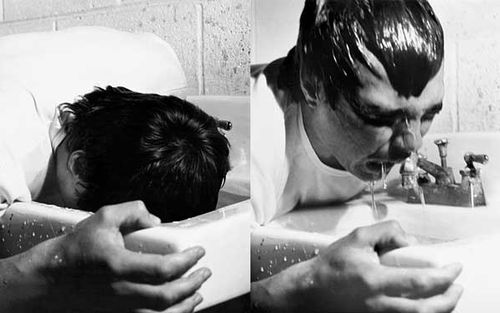
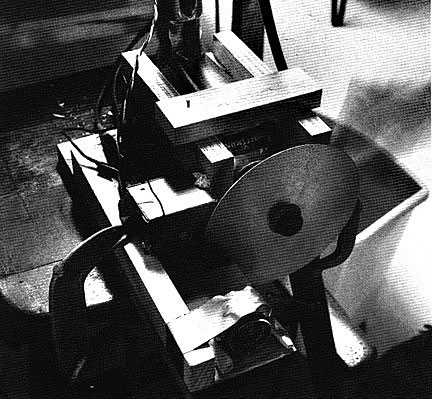

C.B.T.V., 1977
‘In this work, Chris Burden recreated and demonstrated John L. Baird’s original apparatus – the first television. Burden says, “I believe that, as a technological invention, television is of extreme significance as it is a most successful solution to man’s historic desire to ‘see beyond’ his immediate surroundings, and it has made instant visual communication possible. As technology becomes more and more complex, fewer and fewer people have any understanding of how anything really works. By reduplicating and demonstrating television in its original mechanical and relatively simple form, I hope to enable people to understand the principle behind today’s electronic television.”‘ — Ronald Feldman Gallery
The Big Wheel, (1979)
Three-ton, eight-foot diameter, cast-iron flywheel powered by a 1968 Benelli 250cc motorcycle, 112 × 175 × 143 inches.

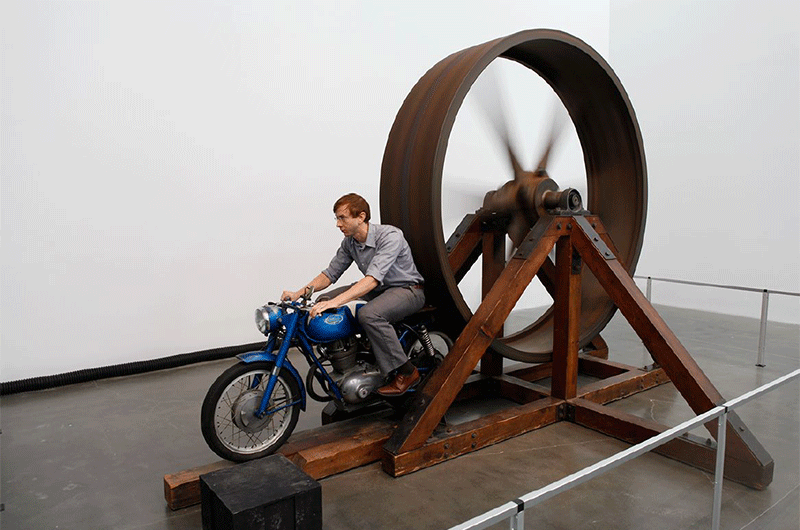


The Reason for the Neutron Bomb, 1979
50,000 nickels and 50,000 matchsticks, 30 ft. 8 in x 17 ft. 6 in.
A Tale of Two Cities, 1981
‘Burden’s A Tale of Two Cities is an installation of 5,000 toys set up on a sand and coral landscape, showing two cities at war. Since it was conceived in 1981, however, it has fallen into ruin, so much so that Burden wanted to just get rid of the thing once and for all and blow the motherf**ker up. According to Burden, such an act would just change the state of the work: “That was more metaphoric—I was trying to illustrate the fluid nature of the work. The work of art would still exist, but it would be rubble.” Conservators at the Orange County Museum of Art in California, the institution that purchased A Tale of Two Cities in 1987, were able to convince Burden to let them fix the decaying piece.’ — Complex
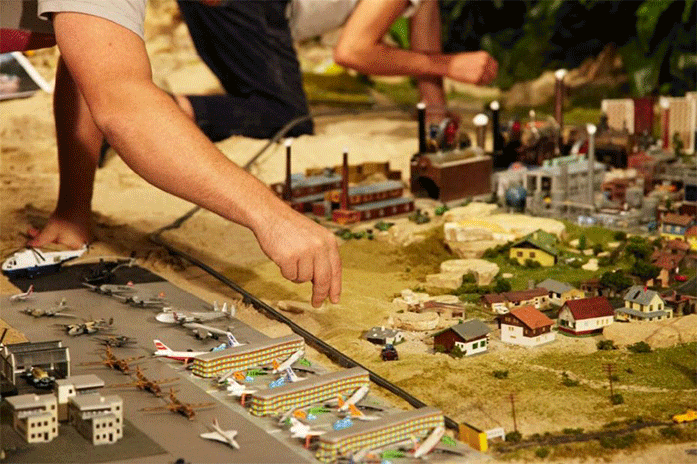
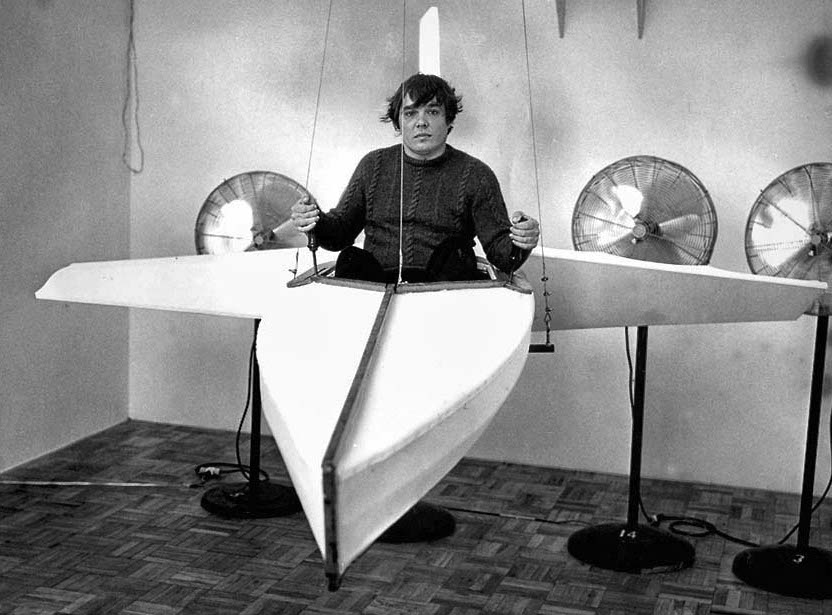
The Flying Kayak, 1982
‘It consists of a fabric-covered frame in the shape of a little one-person boat. it hangs suspended about four feet above the gallery floor on three thin but sturdy steel cables. The kayak is unusual because it possesses a tail assembly reminiscent of a glider plane. Its vertical member can be moved with a foot pedal inside the kayak. Wing-like horizontals are controlled by handy hand levers. Several large fans are set in motion behind and one soars into a tame blue yonder consisting of a film-loop of sky projected on the wall ahead.’ — William Wilson
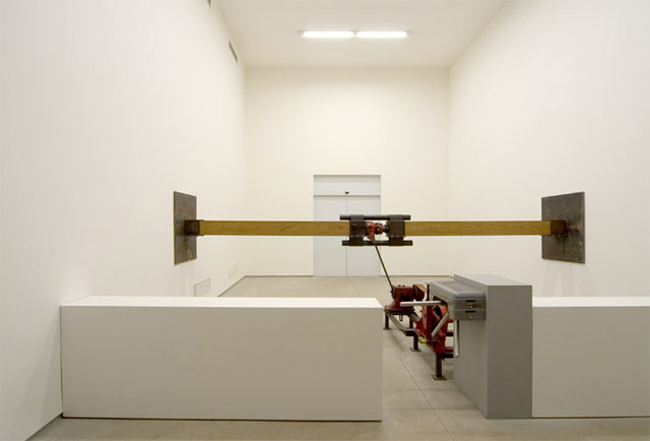
Samson, 1985
‘A museum installation consisting of a 100-ton jack connected to a gear box and a turnstile. The 100-ton jack pushes two large timbers against the bearing walls of the museum. Each visitor to the museum must pass through the turnstile in order to see the exhibition. Each input on the turnstile ever so slightly expands the jack, and ultimately if enough people visit the exhibition, SAMSON could theoretically destroy the building. Like a glacier, its powerful movement is imperceptible to the naked eye. This sculptural installation subverts the notion of the sanctity of the Museum (the shed that houses the art).’ — Zwirner & Wurth
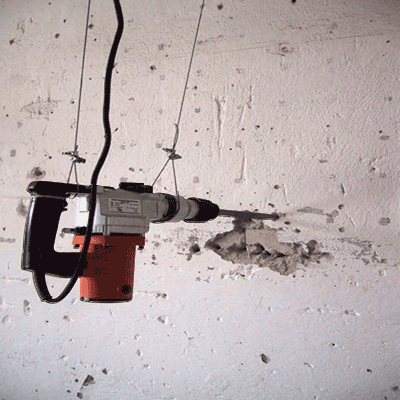
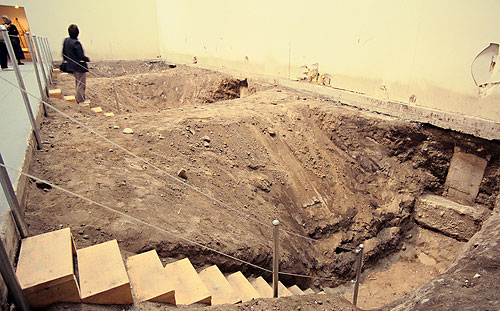
Exposing the Foundation of the Museum, 1986
‘ Chris Burden dug three large trenches in one corner of the Museum Of Contemporary Art in Los Angeles, exposing the dirt and rock underneath the modern museum floor. Underneath the posturing and pretense of the art world, underneath our amazing ability to create art, these trenches looked like beautiful altars where one could contemplate spirituality, sensuality, art or dirt! Video after the jump.’ — Sam Phillips

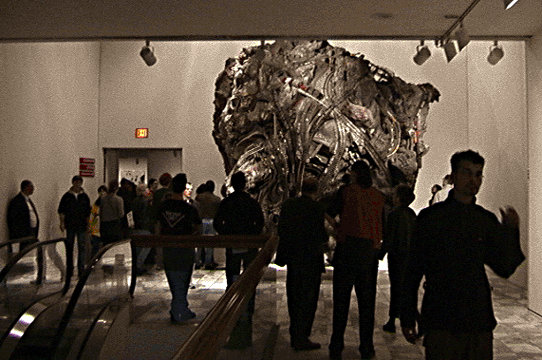
Medusa’s Head, 1990
Plywood, steel, cement, rock, model railroad trains and tracks, 14′ (426.7 cm) in diameter.
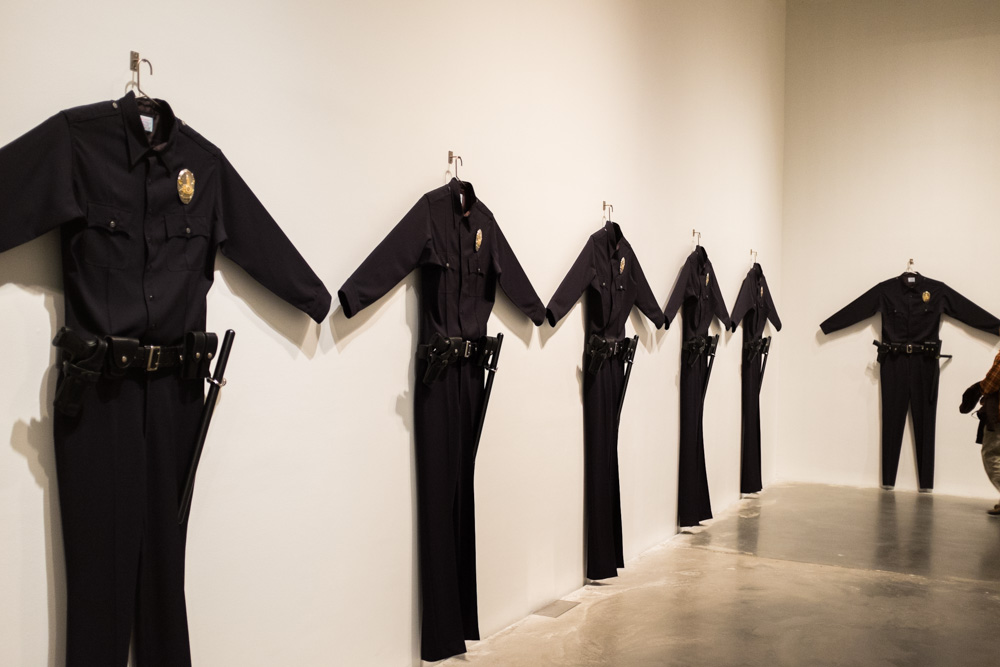

L.A.P.D. Uniforms, 1993.
Wool serge, metal, leather, wood, plastic, Berretta handguns, …

Nomadic Folly, 2001
Wood Platform, 4 Cloth and Metal Umbrellas, Woven Carpets, Braided Ropes and Pillows, Silken Fabrics, Glass and Metal Lamps, and CD Player & Speakers, 11 1/2 × 20 × 20 in, 29.2 × 50.8 × 50.8 cm

Gold Bullets , 2003
10 gold bullets and 2 wood Plexiglas vitrines, 6 1/4 × 10 1/4 × 5 3/4 in
Ghost Ship, 2005
‘On 20th June 2005, Ghost Ship, a crewless self-navigating sailing ship set sail from Fair Isle in remote north-eastern Scotland on an eight-day voyage to Newcastle upon Tyne. Audiences were able to track the boats progress via a live, daily updated website.’ — collaged

The Flying Steamroller, 2006
‘A steamroller was connected to a large, counterbalanced pivot arm. When driven at speed the streamroller left the ground, centrifugally flying.’ — MoMA
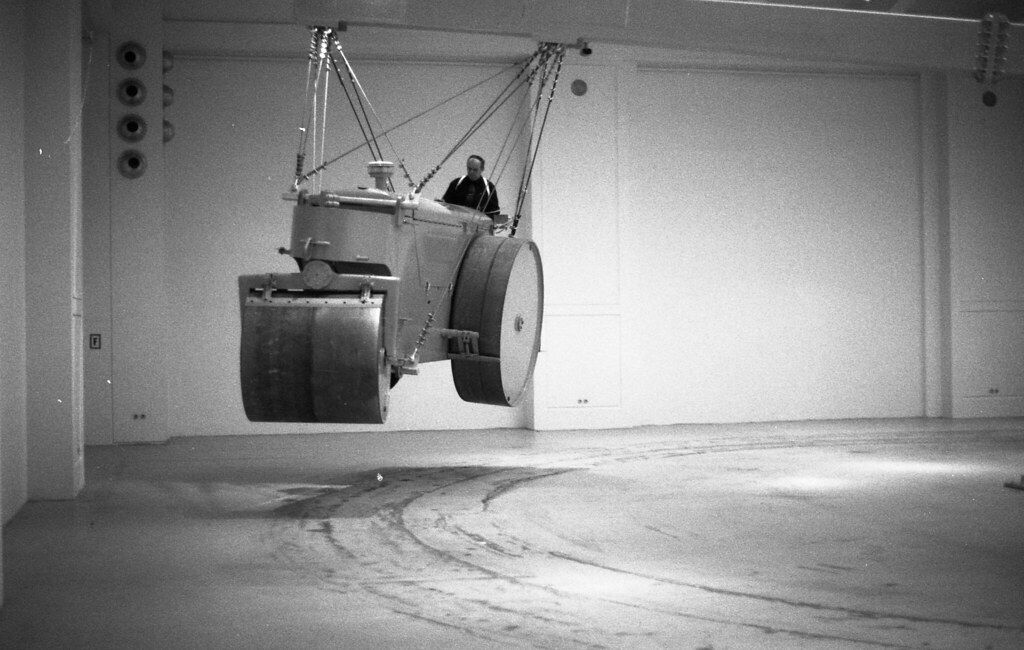
What My Dad Gave Me, 2008
Appx. 1,000 stainless steel reproduction Mysty Type I Erector parts, nuts and bolts
65′ x 11′ 2″ x 11′ 3″ (19.8 x 3.4 x 3.4 m)

Beam Drop, 2008
‘Part-installation and part-performance, “Beam Drop,” involves hoisting steel I-beams high up in the air with a crane and then dropping them climactically into a pit of wet concrete. Burden does not know exactly where his I-beams will fall, so “Beam Drop” forms by chance. Burden relies on a crane to randomly place the I-beams.’ — Complex
Metropolis II, 2011
‘Chris Burden’s Metropolis II is an intense kinetic sculpture, modeled after a fast paced, frenetic modern city. Steel beams form an eclectic grid interwoven with an elaborate system of 18 roadways, including one six lane freeway, and HO scale train tracks. Miniature cars speed through the city at 240 scale miles per hour; every hour, the equivalent of approximately 100,000 cars circulate through the dense network of buildings. According to Burden, “The noise, the continuous flow of the trains, and the speeding toy cars produce in the viewer the stress of living in a dynamic, active and bustling 21st century city.”‘ — LACMA


Ode to Santos Dumont, 2015
‘The kinetic artwork “Ode to Santos-Dumont” is artist Chris Burden’s final work. Alberto Santos-Dumont is considered the father of aviation in France. He flew an airship held aloft with a hydrogen filled balloon to cruise the boulevards of Paris at the turn of the century. In 1901 he won the coveted Deutsch de la Meurthe Prize when he flew his airship around the Eiffel Tower. I have been inspired by the imagination and experimentation of Santos-Dumont. Through the inspiration of Santos-Dumont’s airships, I enlisted master machinist John Biggs to hand craft a 1/4 scale replica of 1903 De Dion gasoline motor. After working on and testing the motor for 7 years, the motor was completed and functional in 2010. In 2014, after much experimentation with propellers, building the gondola out of aluminum Erector parts, installing the engine and mounting mechanisms, and after working with a balloon manufacturer to produce the cigar shaped balloon, we employed our knowledge of engineering and physics to realize the sculpture Ode to Santos-Dumont. The airship sculpture, Ode to Santos-Dumont, is a highly balanced and refined mechanism. The airship travels indoors in a 60 foot circle. It is tethered from the inboard side with very thin, almost invisible threads to central hard points in the ceiling and the ground. The balloon is filled with helium to neutral buoyancy and the motor is just powerful enough to push the balloon in a 60 foot circle. If the airship were to deviate from its 60 foot circle, the geometry of the tethers would force the balloon to turn in a smaller tighter circle, which would cause the motor to work harder. As a result, the airship and its motor always seek the 60 foot circle, which is the path of least resistance, or the sweet spot. The sculpture Ode to Santos-Dumont was made possible through the ability, inquisitive and good nature, determination, and patience of master craftsman and inventor John Biggs. — vernissage
*
p.s. Hey. ** Uday, Hi. I think the music box book would be totally possible. Finding a publisher to put it out would be the only issue. Hm. Lucky you to have gotten to see the John Waters retrospective. I was really hoping to see it, but I don’t think I’m going to get back to LA in time, grr. Parties, incoherence, very nice. This week my collaborator Zac and I will be sitting in a studio working on our film’s sound mix with an editor every day. Good stuff, but not destined to provide spectacular descriptions. Enjoy the outdoors and what it has to offer, assuming you’re relatively free as a bird comparatively. ** Dominik, Hi!!! Yury is a former hair stylist, so he does my haircuts. I’ve just waited a little too long to ask him to give me the usual trim. I’m going to try to get the scissors in his hand today. Apparently the world famous Lascaux cave here in France got too fragile to be tromped through by tourists, so they’ve built an exact fake replica of the cave next to it for tourists to go through, and I’m kind of excited to do that. I do like fakeness. Okay, then, love seeing the error of his crack binging ways after, oh, a nice insane few days or week and checking himself into rehab, G. ** Charalampos, Hi. I think my fave Waters are ‘Female Trouble’ and ‘Serial Mom’. “Role Models’ is great. There’s an excellent chapter on the sublimely great and far too under-read Ivy Compton-Burnett in there. I mean, your Pecker-vision makes a certain kind of sense, and that’s enough. ** Zak Ferguson, Hi. Yep, yep, and John is kind of the greatest human being in the world to boot. The ‘Liarmouth’ film is not yet a done deal. It’s getting more plausible, but there are still numerous hoops to jump through before/if he gets to make it. ** Tosh Berman, ‘Serial Mom’ is a masterpiece, and I think he’s got at least a couple more of them as well. Well, yeah, I tend to write about things that scare and freak me out, so, yes, related writing is the ‘cure’ if there is one. And at least a little cheaper than a Freudian analyst. ** Bill, Hi. I think very highly of ‘Cecil B. Demented’ and I do strongly recommend seeing that. Furlong is a total wreck. I don’t know if you’ve seen recent photos of him, but they help explain why he isn’t making a lot of movies anymore. We’re up to 6 degrees centigrade today! Whoop! Glad your anxiety is biting the dust. ** Justin, Hi, Justin! Welcome, nice to meet you! I adore ‘Serial Mom’. It’s so extremely underrated, I think. Kathleen Turner should have won the Best Actress Oscar among other things. Thank you very much about ‘I Wished’. If you feel like hanging out and filling me in on you and you and yours, that’d be cool, but no pressure at all. Thank you for coming inside. ** Darby🥔, Hi. I wrote to you yesterday. Sorry to be slow. My weekend was … okay, I think. Mostly. Highlights amongst the non-highlights. I want a lentil burger, like, right now. Soul mates are hard to find even at the best of times. I only have a very few, but it only takes one or two to be enough, it feels like. You’ll find ’em. Trust me. The South does sound tough. I’ve always found it pretty tough when I’ve visited there. Although I think I remember thinking Atlanta was kind of okay. Sure, cultures in different places are totally different or can be. Like the culture here is almost the opposite of LA’s, for instance, although both are really good. ** Steve Erickson, Interesting that the Korine is going to be rolled out like that. Someone has their head screwed on right. I wonder if they’ll do the same thing here? His films are very well liked and regarded here, well, except for that previous one, which never got released here as it was thought too poorly of by the French cinematic powers that be. Dying to see ‘AD’. I’m still confused by what exactly is going to happen to Pitchfork. People seem to be speculating and doomsaying wildly. It was still there doing its usual stuff as of Saturday. ** _Black_Acrylic, Yes! I was hoping you’d pop in with the golden link! Everyone, Perhaps you know or know of _Black_Acrylic’s incredible audio show Play Therapy v2.0. It was a glorious sonic staple to me and many others for a long time, but it ceased existence for a painful period of time. However, it’s finally back and, to hear its maker, ‘more experimental and weird than ever’. I so strongly suggest that you join the true believers and joy receivers by clicking this link It’s great!!!!! ** Misanthrope, Bleh indeed. LA shuts down if it gets, like, 3 or 4 inches of rain because it’s so unequipped to deal with anything but sun and a mild breeze. Oh, jeez, obviously get David to the ER. Lord, what next. ** Billy, Hey, Billy. Well your lack of panicking is the good news I am concentrating on. Have a bunch of friends in AA. They don’t seem to think it’s so bad, or they never talk about it, but I guess maybe you’re not supposed to, I don’t know. You found one of the cool 60 year olds, whew. They’re out there. Best of luck with today and everything. ** Okay. I decided to give my galerie the treat of filling it with a show by the late, great Chris Burden, and I think that treat will extend to y’all. See you tomorrow.




 Now available in North America
Now available in North America 
Hi!!
Reading about “Bed Piece” for the first time made such a huge impression on me. I probably would’ve gone mad. Thank you for today’s post! A few more pieces and words to think about.
Ah, that’s very lucky – having someone who’s good with hair in such close proximity. I hope today’s the magic day!
Haha, everything for tourism! A fake cave does sound safer than a real one, though, so even I might be tempted to give it a shot.
I can feel love’s gratitude radiating toward you. Right after he’s done being extremely paranoid and anxious. Alright then. Love leaving rehab after 30 days and managing to stay clean, Od.
What an interesting post today. I recognize the Doorway to heaven image from one of those Decades in art books I liked to read as a teen , and the Volkswagen image maybe from I.D magazine. Two recent not so recent films come to mind in connection with Chris Burden: “Sick of myself’ that I have not seen and “Welcome to me” with Kirsten Wig. Im rather fond of the idea of intervention in television broadcasting. Another film coming to mind.. “Chistine” (Chubbuck, news reporter on air suicide by gunshot) Interesting that these films center around women protagonists.
I am peddling the second music video appropriated from Jon Blackstone’s super 8 70’s home videos he shot as a kid. I hope he does not mind. This one I compiled has the gold. The video accompanies my demo song “Two kids” Pretty ruff recording .. all I can manage atm recording audio with just my phone. Lets call it a ruff sketch. https://youtu.be/I7rl0TZ0A-w?si=UoGw0JA7sMDQxzaQ
Hi Dennis, woo hoo Chris Burden! I wrote a bit about him in Solvent Form and I also included some stuff in the discussion a while back about SAMSON when I was interviewed for that Guardian article on Hirst and destruction, but they didn’t include any of it. haha so maybe it’ll make its way into something else at some point. How are you?
Dennis Biennale : As Peter Schjeldahl once wrote, “Chris Burden, who gave performance a shot in the arm.” I incorporated “Metropolis II” into 1 of my recent “theories.” (Also Michael McMillan’s “Central Meridian”.) Sabrina and me nearly done cleaning up our opus pocus. Gathering the visual assets today… Excitement is gathering in the (my) cosmos… Hey, we all Wanna see that trailer !!! xoxo Jack Torrance
Chris Burden was always a hero to me at art school, Shoot especially. It was enough to get him talked about in hushed tones.
I’m going back to thinking about the writing class today, as homework will be due later in the week. We’re doing a novella in Flash and I have to think of a character to focus on, not the easiest thing to do at the drop of a hat. Think I should probably read some Hemingway as he is said to be a master of this form.
Dennis, The funny thing is that the roads were clear. I tried calling that stupid doctor today and kept getting a busy signal. Yes, busy signals still exist.
Right? What’s next is I don’t know. He still hasn’t gone to get it looked at. He has insurance. He’s just so lazy about things. Well, except for acquiring and doing opioids. He can’t work but he can run around DC all night getting drugs.
With regards to Through The Night Softly, 1973, I remember this clearly, in a sleepy manner. I was watching late-night TV, and I can’t remember if it was a movie or even a late news broadcast, but all of a sudden, this came on my little black and white TV set, and the juxtaposition of not being aware of this is happening, as well as about to fall asleep – and this was on a commercial TV station, although a local Los Angeles station was a weird and wonderful experience. The context of seeing something unexpected like Burdon’s piece is something I will never forget. Of course, a great artist!
Hi Dennis. How are you/’s everything with the film? I hope amazing. Oh, Chris Burden, very wonderful! Are you bigger fan of his sculpture pieces or his performance pieces? Assuming you’re a fan, which you may not be. New York’s parks are extremely gemlike. I can imagine it’s only more the case for the Tuileries. There’s a kind of park in my parents’ home town that’s actually all rocks. I’m sorry for another late response, there’s sort of a lot happening where I am. But thanks so much for the encouragement, and I obviously agree, maybe you do have to feel a bit terrified to really hit creative paydirt. Here’s something which may or may not be from a cave but I think would be an interesting feature of one: http://tinyurl.com/yedxawtm
Was Burden a part of the arts scene you participated in ’70s L.A.? Maybe he was really behind the legendary Max Headroom TV hacking incident in Chicago!
Pitchfork ran an excellent piece by Simon Reynolds looking back at the Cocteau Twins’ HEAD OVER HEELS Sunday and two album reviews today. So the change to a GQ vertical isn’t happening immediately, but who knows when the site will make the leap?
My two latest reviews for Slant Magazine came out today, on noise-rap group Angry Blackmen’s LEGEND OF ABM (https://www.slantmagazine.com/music/future-islands-people-who-arent-there-anymore-album-review/ ) and Future Islands’ PEOPLE WHO AREN’T THERE ANYMORE (https://www.slantmagazine.com/music/future-islands-people-who-arent-there-anymore-album-review/)
Hi Dennis! Viewing Chris’ work, I couldn’t help but think about Permanent Green Light and Roman’s ultimate bit of performance art at the film’s climax. Such a haunting scene.
I find myself in meetings when I’m not in class, so I fear my week is as unremarkable as yours. It should be illegal for anybody under the age of 20 to even know what a meeting is. The fake cave is so fascinating! I don’t know why everybody gets so cracked up about say fake paintings I’m often more impressed by them than the real ones. Hope your hair goes well. If all else fails you can always get the dreadful new perm that’s going around like the flu.
I love Chris Burden! I like when he slithered on glass but I don’t know why he did that.
I like that Russian political activist who nailed his cock to the Moscow square. Wow!
Don’t apologize I just saw it a bit ago actually, in time too because today is a convenient day for me to be at the post office. I’ll throw the book in and seal it.
Wooo!
I will email you though when its totally confirmed, definitely.
I think you will be a little bit surprised by some things. Though I hope the creative liberties I took, plus the cheeky packaging won’t give the impression that I’m super immature.
I am so bad at being serious, but i don’t think its a flaw—well i guess it could be.
Anyways I shall be leaving in the form of a rat and will return in a couple days.
ᘛ⁐̤ᕐᐷ